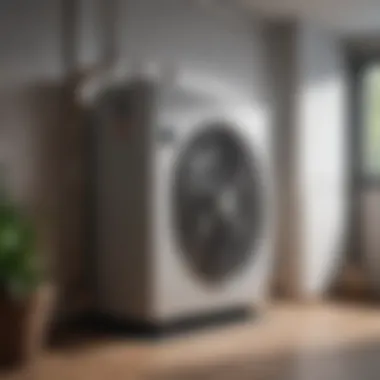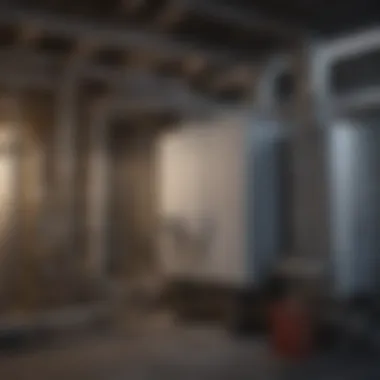Transforming Gas Boilers to Heat Pumps: A Complete Guide


Intro
As we move towards a more sustainable future, the transition from gas boilers to heat pumps becomes an increasingly relevant topic. This process not only represents a shift in heating technology but also underscores a broader commitment to reducing carbon emissions and embracing renewable energy solutions. For professionals in the field and curious individuals, understanding the mechanics behind this conversion is essential.
Gas boilers have been used for decades to provide heating in homes and commercial buildings. However, they are associated with high greenhouse gas emissions and rising fuel costs. Heat pumps, on the other hand, offer a promising alternative. They utilize electricity to move heat from the outside air or ground into a building, thus providing a more energy-efficient solution. With advancements in technology, the benefits of heat pumps are becoming clearer, and many are considering making the switch.
In this comprehensive guide, we will delve into the methodology of converting gas boilers to heat pumps. Beyond the technical aspects, we will explore the economic and environmental considerations that accompany this transition, as well as the practical steps for implementation. Our goal is to create a roadmap that is both informative and actionable, catering to a diverse audience eager to innovate in energy efficiency.
Let's begin this journey by examining the methodology of this conversion process.
Preface to Boiler and Heat Pump Technology
The process of converting gas boilers to heat pumps is gaining importance in the context of rising energy costs and environmental concerns. In this section, we will explore the key components that underlie both gas boiler and heat pump technologies. A solid understanding of these systems is essential for making an informed transition.
Overview of Gas Boilers
Gas boilers have long been a staple in domestic heating systems. They work primarily by burning natural gas to heat water, which then circulates through radiators or underfloor systems. This method is effective for providing warmth. However, there are notable downsides. Gas usage contributes to greenhouse gas emissions and fluctuating fuel prices can impact household budgets. Furthermore, as energy regulations become stricter, the reliance on fossil fuels raises questions about long-term viability.
Understanding Heat Pumps
Heat pumps, on the other hand, provide a more energy-efficient heating solution. They extract heat from the environment—either from air, ground, or water—and use it to warm up the living spaces. The technology relies on electricity, making it compatible with renewable energy sources. Thus, it has the potential to drastically reduce carbon footprints. While installation may involve upfront costs, heat pumps can lead to long-term savings in energy bills and maintenance costs. Knowledge about heat pumps can guide homeowners in evaluating the benefits of making the switch.
Comparative Analysis of Efficiency
When comparing the energy efficiency of gas boilers to heat pumps, one must consider several factors. Heat pumps generally operate at a coefficient of performance (COP) of 3 to 4. This means for every unit of electricity consumed, they generate three to four units of heat. In contrast, gas boilers convert fuel directly into heat, typically with efficiencies ranging from 80% to 95%.
To highlight the disparity:
- Heat Pumps: High energy efficiency due to their method of extracting heat.
- Gas Boilers: Limited by the amount of gas consumed, not as efficient overall.
This analysis reveals that while gas boilers provide immediate heating solutions, heat pumps offer a more sustainable approach in the long run. As global energy priorities shift, the need for alternatives like heat pumps becomes a pressing issue for homeowners.
The Case for Conversion
The transition from gas boilers to heat pumps represents a significant shift in how we approach heating and energy efficiency at home and in industry. It is no longer just an environmental consideration; it involves a complex interplay of economic, regulatory, and practical factors. This section aims to elucidate why this conversion is not merely advisable but essential in today’s context.
Environmental Benefits
One of the most compelling reasons to convert from gas boilers to heat pumps is the profound environmental advantage. Traditional gas boilers emit considerable amounts of greenhouse gases, contributing to global warming and climate change. In contrast, heat pumps utilize renewable energy from the environment, such as air or ground heat, resulting in dramatically lower emissions. This shift can assist in reducing overall carbon footprints.
Consider the following points regarding the environmental benefits:
- Lower Carbon Emissions: Heat pumps can reduce carbon emissions by up to 50-70% compared to gas boilers, depending on the energy source.
- Sustainability: By harnessing natural energy sources, heat pumps contribute to sustainable energy practices, aligning with global climate goals.
- Improved Air Quality: Reducing reliance on gas heating can lead to cleaner air in urban areas, directly benefiting public health.
"Transitioning to heat pumps contributes not just to individual households but also positively impacts larger community health and environmental standards."
Economic Incentives
Apart from environmental concerns, economic factors play a crucial role in the case for conversion. The cost of energy is a significant consideration for both homeowners and businesses seeking long-term savings.


- Lower Operating Costs: Heat pumps generally have lower operating costs after installation compared to gas boilers. Although the initial investment might be higher, the savings on energy bills can be considerable over time.
- Government Incentives: Many governments offer financial incentives, tax rebates, and grants to encourage adopting heat pump technology. This financial support mitigates installation costs and promotes the shift.
- Increased Property Value: Homes equipped with energy-efficient systems, like heat pumps, may see an increase in property value due to rising demand for eco-friendly living.
Regulatory Considerations
Regulatory frameworks are critical in this landscape. Governments around the world are moving toward stricter regulations regarding energy efficiency and carbon emissions. The transition from gas to heat pumps is often incentivized by policy changes focused on achieving net-zero emissions targets.
Key regulatory aspects include:
- Standards Compliance: Heat pumps must meet specific efficiency standards established by regulatory bodies to qualify for incentives and rebates.
- Local Codes and Permits: Homeowners must navigate local zoning laws and building codes, which can influence the installation process of heat pumps.
- Future-Proofing: Engaging with heat pump technology positions property owners favorably against looming regulations aimed at reducing reliance on fossil fuels, thus future-proofing their investments.
Embracing the conversion from gas boilers to heat pumps is not just a technical change; it is a proactive strategy that aligns with environmental, economic, and regulatory frameworks. By understanding these various benefits and considerations, individuals and organizations can make informed decisions that resonate well into the future.
Assessing Compatibility
Assessing compatibility is a crucial phase in the transition from gas boilers to heat pumps. It involves understanding the specific needs of a building and how a heat pump can best serve those requirements. Ignoring this step can lead to inefficiencies and inadequate heating solutions.
Evaluating Heating Requirements
To determine if a heat pump is suitable, it is essential to evaluate the heating requirements of the space it will serve. This involves several key factors:
- Heating Load Calculation: Understanding the amount of energy needed to heat the building in the coldest months. Tools like Manual J calculations can provide insights into the correct sizing of the heat pump.
- Temperature Settings: Assess the desired indoor temperature compared to the outdoor climate. Heat pumps often operate best in moderate climates, but advancements in technology have allowed them to function even in colder regions.
- Usage Patterns: Analyze how often the heating system is used, the size of the living space, and the number of occupants. These details help in determining the appropriate capacity of the heat pump.
It is advised to record historical heating usage data as it can provide clarity on actual temperature requirements and efficiency.
Infrastructure Assessments
Infrastructure assessments play an integral role in evaluating compatibility. This step helps to identify whether the existing infrastructure can support the installation of a heat pump system. Key considerations include:
- Ductwork Condition: Check the state of existing ductwork. If it is leaky or inadequately insulated, heating efficiency may suffer. Upgrades or replacements may be necessary.
- Electrical System: Heat pumps require specific electrical capabilities. Ensuring that the electrical system can handle the load is critical to avoid future problems.
- Space Availability: Identify a suitable outdoor location for the heat pump unit. Adequate space for air circulation is vital for optimal performance.
Taking the time to conduct thorough infrastructure assessments can save time and money during the installation process.
Building Energy Efficiency Standards
Another important element is understanding building energy efficiency standards. Heat pumps are most effective when paired with energy-efficient buildings. This aspect involves:
- Insulation Levels: Evaluate whether the building is well-insulated. Poor insulation can lead to heat loss and significantly reduce the efficiency of any heating system.
- Energy Use Intensity (EUI): Determine how much energy the building uses per square foot. Buildings with lower EUI are generally more compatible with heat pump technology.
- Local Codes and Regulations: Familiarize yourself with local building codes regarding energy consumption and emissions. Compliance with these regulations will be necessary for successful implementation and may influence the decision-making process.
The assessment of compatibility ensures that the selected heat pump system aligns well with the building’s unique needs and characteristics, ultimately leading to a more successful transition from gas boilers.
Technical Considerations for the Conversion Process
When converting from gas boilers to heat pumps, addresss technical considerations carefully. It is critical to ensure that all systems operate effectively and efficiently after the conversion. The correct technical choices can save you from unnecessary complications and costs in future.
Selecting the Appropriate Heat Pump
Choosing the right heat pump is a key step. There are various types, including air-source, ground-source, and water-source heat pumps. Each type has unique characteristics.
- Air-source heat pumps are versatile. They extract heat from the air, making them suitable for moderate climates. However, their efficiency may drop in very cold conditions.
- Ground-source heat pumps draw energy from the earth. They are efficient but require significant installation space and upfront investment.
- Water-source heat pumps utilize water bodies for heat exchange. The proximity to water sources is necessary for their implementation.
When selecting a heat pump, consider the technical specifications. The heating capacity, energy efficiency ratio, and compatibility with your building's requirements should be thoroughly assessed.


Installation Requirements
The installation process requires careful planning. Prepare the existing site for the heat pump. This may involve modifying piping systems, upgrading electrical systems, or even reinforcing structural elements for larger units. First, verify local building codes and regulations to ensure compliance.
The installation must be performed by licensed professionals. Proper installation influences the overall performance and longevity of the heat pump. Neglecting to follow proper procedures can lead to inefficiencies and excessive running costs.
Integration with Existing Systems
Effective integration of the heat pump with existing heating and cooling systems is essential for maintaining comfort and efficiency. Heat pumps can work alongside traditional heating systems, such as radiators or underfloor heating. Evaluate your present system's compatibility. Sometimes, modifications may be necessary.
In particular, control systems should be coordinated with the heat pump to optimize energy use. Smart thermostats can aid in this integration. Utilizing existing ductwork or heating elements can help minimize costs, but ensuring that they can manage heat pump operation is crucial.
"Choosing the right heat pump and ensuring proper installation are integral to a successful conversion from gas boilers."
In summary, focus on these technical considerations for a smooth transition. The selection of an appropriate heat pump, understanding installation requisites, and ensuring seamless integration with existing systems are pivotal in realizing the full benefits of this transformation.
Cost Analysis of Conversion
Understanding the cost associated with converting gas boilers to heat pumps is critical for homeowners and building managers considering this transition. This section provides a comprehensive view of the financial aspects involved in this conversion process. Evaluating both initial and long-term costs helps stakeholders make informed decisions, aligning economic feasibility with environmental benefits.
Initial Investment Projections
When contemplating the conversion from a gas boiler to a heat pump, the initial investment is a significant factor. The upfront cost includes the purchase of the heat pump itself, installation expenses, and any modifications needed to the existing heating system. Here are some key points to consider about initial investment projections:
- Equipment Costs: The price of heat pumps varies widely, depending on the model and features. High-efficiency models often come at a premium but could offer substantial savings over time.
- Installation Costs: Hiring qualified contractors is essential for proper installation. This cost can fluctuate based on complexity and local labor rates.
- Upgrades Required: Buildings may need additional upgrades, such as enhanced insulation or ductwork modifications, which can affect the total conversion cost.
It is critical to have a detailed estimate before moving forward. Homeowners should contact various providers and collect quotes to compare and understand the financial scope.
Long-term Operating Costs
While the initial investment is important, long-term operating costs are equally vital for determining the overall financial impact of switching to heat pumps. Heat pumps can have different operating expenses relative to gas boilers, and comprehending these can lead to better budgeting strategies.
Here are several factors to consider:
- Energy Efficiency: Heat pumps generally operate at a higher efficiency than traditional gas boilers. This can lead to lower electricity bills, especially in mild climates.
- Maintenance Costs: Regular maintenance is necessary for both types of systems. Heat pumps typically require less frequent maintenance, potentially reducing ongoing costs.
- Incentives and Subsidies: Many regions offer incentives for using renewable energy sources. Reducing the effective operational costs through these financial incentives can make a significant difference over time.
It is essential to project these operating costs to understand how they will compare to current gas boiler expenses in the long run.
By analyzing both initial and long-term costs, stakeholders can make a well-informed decision about converting gas boilers to heat pumps, balancing immediate expenses with future savings.
Challenges to Consider During Conversion
When converting gas boilers to heat pumps, it is crucial to understand the challenges that may arise throughout the process. The conversion is not merely a switch from one technology to another; it involves a comprehensive assessment of technical capabilities, financial implications, and communal acceptance. By having a clear understanding of these challenges, stakeholders can better navigate the complexities of this transition.
Technical Challenges
The technical hurdles in converting from a gas boiler to a heat pump are diverse. One critical factor involves compatibility with existing heating systems. Many homes utilize traditional heating setups, which may not be ideal for heat pump operation.
Furthermore, heat pumps generally require a different set-up regarding ductwork or radiators. They tend to operate efficiently at lower temperatures compared to gas boilers. Thus, it may lead to a necessary upgrade in insulation or the installation of larger radiators or underfloor heating systems to ensure adequate heating.
Installation can also be problematic, requiring trained professionals who understand the specifics of both systems. Mismatches can lead to inefficiencies or even failures in the heating system. The integration of smart technology may also be required to fully utilize the advantages of heat pumps, further complicating the technical landscape.
Financial Barriers


Financial considerations present another significant challenge. Converting to a heat pump can incur substantial initial costs. The price of the unit itself, along with installation and any required upgrades or modifications, can be prohibitively high for many homeowners.
Nonetheless, various economic incentives can help mitigate these expenses. Government programs may offer rebates or tax credits for using renewable technology; however, accessing these can often be complex and time-consuming. Furthermore, long-term savings must be carefully considered. Heat pumps usually have lower operating costs compared to gas boilers due to energy efficiency. But, it requires an upfront investment that some homeowners may struggle with.
Public Perception and Acceptance
Public perception plays a pivotal role in the conversion process. Many individuals still view gas boilers as the standard for home heating. Misconceptions about heat pumps—such as perceived inefficiency in colder climates or noise issues—can impede acceptance.
Improving awareness through educational campaigns and showcasing success stories can significantly help shift perspectives. People need to understand that heat pumps can operate efficiently in diverse climates and offer significant environmental benefits by reducing carbon emissions. The role of community initiatives in fostering acceptance is substantial. Local support encourages residents to make informed decisions, leading to a smoother transition.
"Understanding the challenges is just as important as the benefits when considering a switch to heat pumps."
Practical Steps for Transitioning from Gas Boiler to Heat Pump
Transitioning from a gas boiler to a heat pump involves several practical steps that are pivotal in ensuring a successful conversion. These steps determine the efficiency, safety, and effectiveness of the new heating system. The process requires careful planning and execution. Addressing each step thoroughly aids in mitigating potential issues that might arise during and after the transition. It also provides homeowners and businesses with a clearer understanding of what to expect throughout this significant change in their heating systems.
Initial Assessment and Planning
Before any physical changes can occur, a detailed assessment of the current heating system is essential. This involves evaluating the existing gas boiler's performance, analyzing the home's heating requirements, and understanding the limitations of the current infrastructure. Key elements to assess include:
- Current energy consumption and costs
- Type and condition of existing heating infrastructure
- The architectural layout of the building
Careful planning helps identify whether the existing ductwork or radiators are suitable for the heat pump. Heat pumps generally operate more efficiently with low-temperature heating systems. Therefore, if modifications are necessary, it is crucial to map out those changes early on. A solid plan will help ensure that the installation runs smoothly and stays on schedule.
Finding Qualified Contractors
Choosing the right professionals for the conversion is vital. Look for contractors who specialize in heat pump installations. They should possess relevant certifications and experience. Options include:
- Check References: Ask for references from previous installations to gauge reliability and quality.
- Certifications and Training: Verify that your contractors have the necessary training and certifications for heat pump work. This ensures they are up-to-date with current standards and technology.
- Get Multiple Quotes: Obtain quotes from several contractors to ensure competitive pricing and services offered.
A competent contractor will also aid in navigating potential regulatory requirements and local building codes which can vary by region. This involvement is crucial in avoiding legal issues or complications that can arise during the installation process.
Executing the Conversion
The conversion process is where planning meets execution. The installation phase should adhere closely to the established plan. Key considerations during execution include:
- System Removal: Carefully dismantling the gas boiler is the first step. This involves safely disconnecting it from the gas line and ensuring no lingering gas leaks.
- Heat Pump Installation: The heat pump needs appropriate placement. Consider proximity to power sources and ease of access for maintenance. The setup should optimize efficiency, keeping in mind airflow and duct system compatibility.
- Final Checks and Testing: Once installed, the system must undergo testing. This ensures everything operates correctly, verifying system pressures and flow rates align with specified requirements.
Proper execution of these steps ensures a smooth transition and avoids unnecessary delays or costs. Many factors can cause issues, but attention to detail can mitigate risks.
Ultimately, the transition from a gas boiler to a heat pump requires methodical planning and execution. Each practical step plays a critical role in achieving desired energy efficiency, cost savings, and performance. Following these guidelines can help streamline the conversion process, making the move to more sustainable energy solutions not just feasible but also successful.
Ending and Future Perspectives
In the transition from gas boilers to heat pumps, the importance of a comprehensive guide cannot be overstated. This conversion process represents not only a change in technology but also a movement toward sustainable energy practices. Understanding both the practical and technical aspects of this shift is essential for homeowners, policymakers, and industry professionals alike.
Reflecting on the conversion process reveals several key considerations. First, it emphasizes the necessity of educating all stakeholders about potential environmental benefits and economic incentives. This awareness can significantly influence public perception and encourage broader adoption of heat pump technology.
Moreover, the guide illustrates how proper planning can mitigate challenges, ensuring a smoother transition from traditional systems. For instance, recognizing the compatibility of current infrastructure with new heat pump systems is paramount. It provides insight into making informed decisions, reducing the chances of costly modifications or installations down the line.
Future developments in heat pump technology promise to enhance efficiency further and reduce barriers associated with conversion. Advancements in materials, designs, and smart technology integration are expected. These improvements will likely make heat pumps more accessible and cost-effective.
"As technology evolves, the feasibility of heat pumps over traditional gas boilers will continue to grow, aiming for a sustainable future where energy consumption is optimized."
The incorporation of intelligent systems is particularly noteworthy. Smart heat pumps can adapt to external temperature changes, optimizing energy use and ensuring comfort.
This guide serves as a foundational resource for understanding the intricacies involved in converting gas boilers to heat pumps. Stakeholders must remain active in tracking developments in this field to harness the benefits fully.
Moreover, ongoing education and awareness initiatives can foster a culture of sustainability, leading to engaged communities willing to invest in energy-efficient solutions. As the global landscape evolves, collaborations between technology developers and government agencies become crucial in shaping a sustainable energy future.







